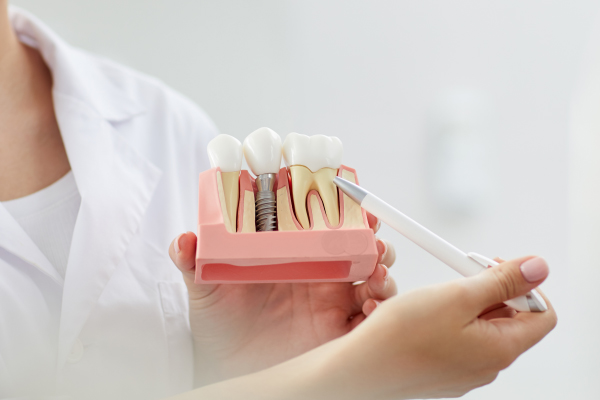 ONLINE APPOINTMENT CALL NOW
ONLINE APPOINTMENT CALL NOW ONLINE APPOINTMENT CALL NOW
ONLINE APPOINTMENT CALL NOW
Dental implants are a proven way to replace missing teeth. Most patients find them comfortable and painless and enjoy how they enable them to bite, chew and swallow easily once again.
Deciding which implant to use is not always easy. A dentist must evaluate a case and choose the right type based on the patient’s needs. There are several factors they need to consider, including how many teeth are missing, the strength of the jawbone, and the health of the surrounding teeth.
Each implant is designed for a specific use. If you need to replace more than one tooth, you may need an All-on-4 solution or implant-supported dentures, whereas a crown may be the best option for a chipped tooth. It’s about finding the right equipment for your oral health, comfort, budget, and lifestyle.
To start, let’s look at the different types of implants, including the All-on-Four system, implant-supported dentures, bridges and crowns. For each of them, we will explore which scenarios they are ideally suited to.
Let’s Explain What a Dental Implant is
A dental implant is a metal frame that is surgically bonded to the jawbone. It is an appliance designed to hold an artificial tooth securely in place. The artificial tooth replaces the missing one, filling the gap and preventing problems such as overcrowding and displacement.
Dentures were one of the earliest methods to replace missing teeth. They were uncomfortable and made it difficult for patients to speak clearly or chew food. They also required some maintenance and were susceptible to breakage. For some patients, implants have made wearing dentures less cumbersome or even completely replaced them.
Benefits of modern implants include holding dentures and bridges in place, preventing additional tooth or bone loss, and eliminating facial depression. They also resist decay and help replacement teeth feel natural in a person’s mouth.
Can improve speech and more specifically pronunciation
Provide protection for your jawbones and teeth
Durable and affordable
Does not require any special cleaning or maintenance
If you need dental implants, it’s best not to delay. Visit your dentist so they can examine your mouth, determine which implant makes the most sense, and begin creating an appropriate and effective treatment plan.
Pros and Cons of Dental Implants
Are dental implants right for you? Compare the pros and cons below:
Pros :
Implants function like your own teeth, allowing you to chew and speak normally.
Designed to resemble your natural teeth, it increases your self-confidence.
Reduce stress on your remaining natural teeth by providing independent support.
Protect bone by reducing the appearance of aging.
Help prevent loss of chin height.
It is easy to clean and maintain.
With proper care, implants can last between 15 and 25 years. They also typically last longer than dental bridges and dentures.
Cons:
Living with Missing Teeth..
Teeth serve an important function in the mouth and can contribute to overall health. Missing a single tooth can cause misalignment, as teeth can shift to fill gaps. This can cause crooked teeth and make your oral hygiene routine more difficult.
Additionally, a gap in one row of teeth can cause adjacent teeth to erupt. This is because a tooth is overcompensating to fill a gap because there is no other tooth to stop it.
Other consequences are osteoporosis, or a condition where the gums and jaws deteriorate, causing cheeks to look sunken or sullen and making you look older.
Dental implants have come a long way over the years, and whatever your situation, there should be a solution. Your dentist’s role is to ensure that you do not have to live with any of these symptoms for a long time.
All-on-4 is a proven and adequate way to replace multiple missing teeth. This system offers exceptional functionality and can withstand the rigors of chewing and biting.
People with missing teeth or advanced gum disease often have some bone loss. All-on-4 is a unique system as it makes the most of the available bone in the patient’s jaw to place implants. It is designed to maximize bone removal, eliminating the need for additional procedures such as bone grafting, which can be expensive and painful.
The process involves using computer technology to analyze a patient’s jawbone to find the best areas to place implants. Once they are in place, artificial teeth can be attached. The surgery is considered routine and usually takes about 90 minutes. Remember that every case is different and your dentist will discuss the specifics of your surgery when the time comes.
The final step involves your dentist creating a post-treatment plan to ensure your recovery is uneventful. After surgery, patients can usually drink immediately but are advised to eat soft foods for three months. They need to attend check-ups and cleanings every 6-12 months to make sure everything is in order.
This procedure has achieved a 98% success rate over the last decade. It is often recommended as an alternative to traditional prostheses, especially in patients with reduced jaw bones.
Implant-supported dentures innovatively combine the functionality of a removable denture with the stability of a dental implant. It allows dentists or specialists to adjust the degree of dentures, helping to avoid the use of specially designed instruments.
Implant-supported dentures minimize the painful sores and laxity associated with traditional dentures. They do not require patients to use dentures, and some do not even have a plate to cover their mouth. They are painless, effective, and the result is often greater comfort and increased confidence.
This treatment is generally recommended for patients who need a prosthesis and have adequate bone support.
A dental bridge can close the gap caused by a missing tooth and is used when more than one tooth is missing. Bridges can preserve the shape of a patient’s face and help them achieve a healthy bite by keeping the artificial teeth where they should be. Plus, these dentures look and feel natural.
Bridges can restore a smile by distributing the force exerted by biting and chewing, preventing real teeth from shifting into spaces. They are bonded to real teeth and are made of gold, alloy, porcelain, or some combination of these materials.
A dentist typically recommends a patient receive a bridge if the missing teeth are on one side of the mouth or if there are not many teeth to replace.
Dental crowns are designed to improve the strength, shape and functionality of a tooth. This restorative procedure is often used to repair teeth that are broken, worn, or affected by tooth decay.
Think of a crown as a cap that is placed over the tooth, providing a new outer surface to protect it from bacteria or other harmful elements. Crowns are durable, made of porcelain or metal, or a combination of the two. Aesthetically, patients often prefer porcelain crowns because their appearance is very similar to natural teeth. If a tooth does not have enough strength to hold a filling, then the patient may require a partial crown.
Crowns are created and shaped by dental laboratory technicians based on a patient’s unique impression. The technician will use this impression to evaluate the patient’s bite and jaw movements. The goal is to ensure that a crown does not interfere with biting, chewing, or swallowing and to help the patient achieve full mouth function.
So How to Make an Implant Step by Step?
Dental implant procedures are divided into multiple steps depending on the number of implants the patient needs:
Step 1 — Remove the Tooth
If the damaged tooth is still in your mouth, the dentist will extract the tooth. If your tooth is already missing, this step is not necessary.
Step 2 — Grafting and Jawbone Preparation
Many patients who have implant surgery have thin or soft jaw bones. Bone graft, which increases the amount of bone, ensures that the procedure does not fail. Options include a synthetic bone graft, such as a bone substitute, or a natural graft, which means bone taken from another part of the patient’s body. The healing process of bone grafts takes several months before a dental implant can be placed. Fortunately, grafts are not always necessary.
Step 3 — Implant Placement
During the actual procedure, the oral surgeon cuts through the gums with small tools, exposing the bone. An oral surgeon or periodontist drills holes into the bone. They then place the implant (a post) deep into the bone that acts as the root of the tooth. If a front tooth is being restored, the dentist will fill the empty space with a temporary removable solution while the implant heals under the gums. If it is the back tooth, they do not put anything on it.
Step 4 – Healing and Growth
Osseointegration begins after the metal implant is placed in your jawbone. This is when the supporting bone begins to fuse with the implant. This process can take several months to complete and ensures that the base is strong enough to support an artificial tooth (dental crown).
Step 5 — Abutment Placement (Crown Preparation)
Once the healing process is complete, your dentist will place an abutment over the implant post. The abutment extends the implant over the soft tissue (gums). This step allows easy placement of the dental crown.
Step 6 — Crown Placement (Artificial Tooth)
Once the implant turns into bone and is strong enough to support chewing, your dentist will gain new impressions of your mouth. A dental technician will then create a custom dental crown in the laboratory. An artificial dental crown is similar to your natural teeth. The crown fits over the abutment (connector) and becomes the only visible part of the implant.
Step 7 — Aftercare
Pain medications and antibiotics are often prescribed after surgery. It is also important to eat only soft foods and practice excellent oral care habits during the healing process. It is also important to limit alcohol, caffeine and tobacco intake to see best results.